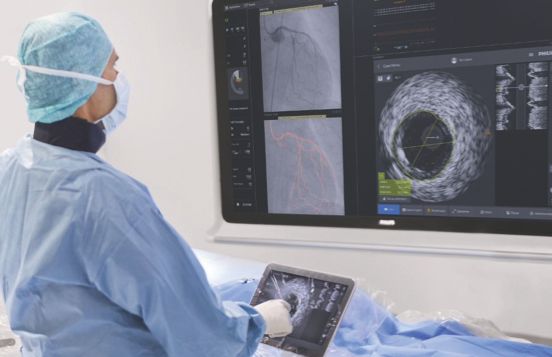
Image-guided therapy
Coronary suite
Transforming complex PCI procedures into confident cardiac care
Philips' coronary artery disease (CAD) solutions consist of advanced clinical and workflow applications, therapeutic and diagnostic devices, and leading services, working together to efficiently support every step of coronary procedures. From diagnosis to restoring vessel patency, the coronary suite ecosystem is designed to enhance performance and efficiency today while serving as your launching pad to the future and keeping you close to the heart of CAD.

Improving cath lab performance while staying close to the heart
In the complex cath lab landscape, you need to know your path in advance. Philips offers a fully integrated ecosystem designed to meet today’s challenges and provide you with more information faster. This enhances cath lab performance, supporting confident decisions and exceptional patient care. Our CAD solutions work together to help you provide quick, confident diagnosis, along with effective, efficient treatment – ultimately contributing to improved outcomes.[1]
Azurion 7 M12 - the heart of our solution for cardiac care
Proven to reduce procedure time by 17%[2] by experiencing the outstanding performance of the Azurion 7 M12. This industry-leading image-guided solution supports better patient care and operational efficiency with seamless control from a single tableside touchscreen for fast, informed decisions in the sterile field.

Dynamic Coronary Roadmap - find your path
Find the right path and improve PCI outcomes. This Philips exclusive solution offers motion-compensated, real-time navigational guidance of coronary arteries and reduces contrast agent use by 28.8%.[3]

IntraSight - when every tiny move matters
Philips IntraSight offers you a comprehensive suite of clinically proven[4-8] imaging, physiology and co-registration[9] tools on a modern, secure platform that will help you simplify complex interventions, speed routine procedures and improve lab efficiencies.

Enabling technologies for Coronary suite
Related procedures
Footnotes
- Coronary IVUS Technologies Intravascular imaging improves outcomes and reduces death Stone G, et al. Intravascular imaging-guided coronary drug-eluting stent implantation: an updated network meta-analysis. Published Online February 21, 2024 https://app.contentful.com/spaces/fzjlyokyl1wq/environments/master/entries/5H9mL1ltYniTWMm296g289
- Philips whitepaper 12nc 4522 991 30501;Reduction of procedure time by 17% with Philips Azurion in independently verified study; Philips Azurion Lab Performance Study. Results are specific to the institution where they were obtained and may not reflect the results achievable at other institutions.
- Dynamic Coronary Roadmap versus standard angiography for percutaneous coronary intervention: the randomised, multicentre DCR4 Contrast trial www.documents.philips.com/assets/20240219/0e2a77c4a6904c6eaae3b11b00df6861.pdf
- Davies JE, et al., DEFINE-FLAIR: A Multi- Centre, Prospective, International, Randomized, Blinded Comparison of Clinical Outcomes and Cost Efficiencies of iFR and FFR Decision-Making for Physiological Guided Coronary Revascularization. New England Journal of Medicine, epub March 18, 2017.
- Gotberg M, et al., Instantaneous Wave-Free Ratio Versus Fractional Flow Reserve Guided Intervention (IFR-SWEDEHEART): A Multicenter, Prospective, Registry-Based Randomized Clinical Trial. New England Journal of Medicine, epub March 18, 2017.
- Patel M. “Cost-effectiveness of instantaneous wave-Free Ratio (iFR) compared with Fractional Flow Reserve (FFR) to guide coronary revascularization decision-making.” Late-breaking Clinical Trial presentation at ACC on March 10, 2018.
- A. Maehara, M. Matsumura, Z.A. Ali, G.S. Mintz, G.W. Stone. IVUS-guided versus OCT-guided coronary stent implantation. J Am Coll Cardiol Img, 10 (2017), pp. 1487- 1503.
- Choi K, et al. Impact of Intravascular Ultrasound-Guided Percutaneous Coronary Intervention on Long-Term Clinical Outcomes in Patients Undergoing Complex Procedures. JACC: Cardiovascular Interventions. Mar 2019, 4281; DOI: 10.1016/j.jcin.2019.01.227.
- Co-registration tools available within IntraSight 7 configuration via SyncVision
Disclaimer
Always read the label and follow the directions for use.
Philips medical devices should only be used by physicians and teams trained in interventional techniques, including training in the use of this device.
Products subject to country availability. Please contact your local sales representative.
Trademarks are the property of Koninklijke Philips N.V. or their respective owners. Philips reserves the right to change product specifications without prior notification.





